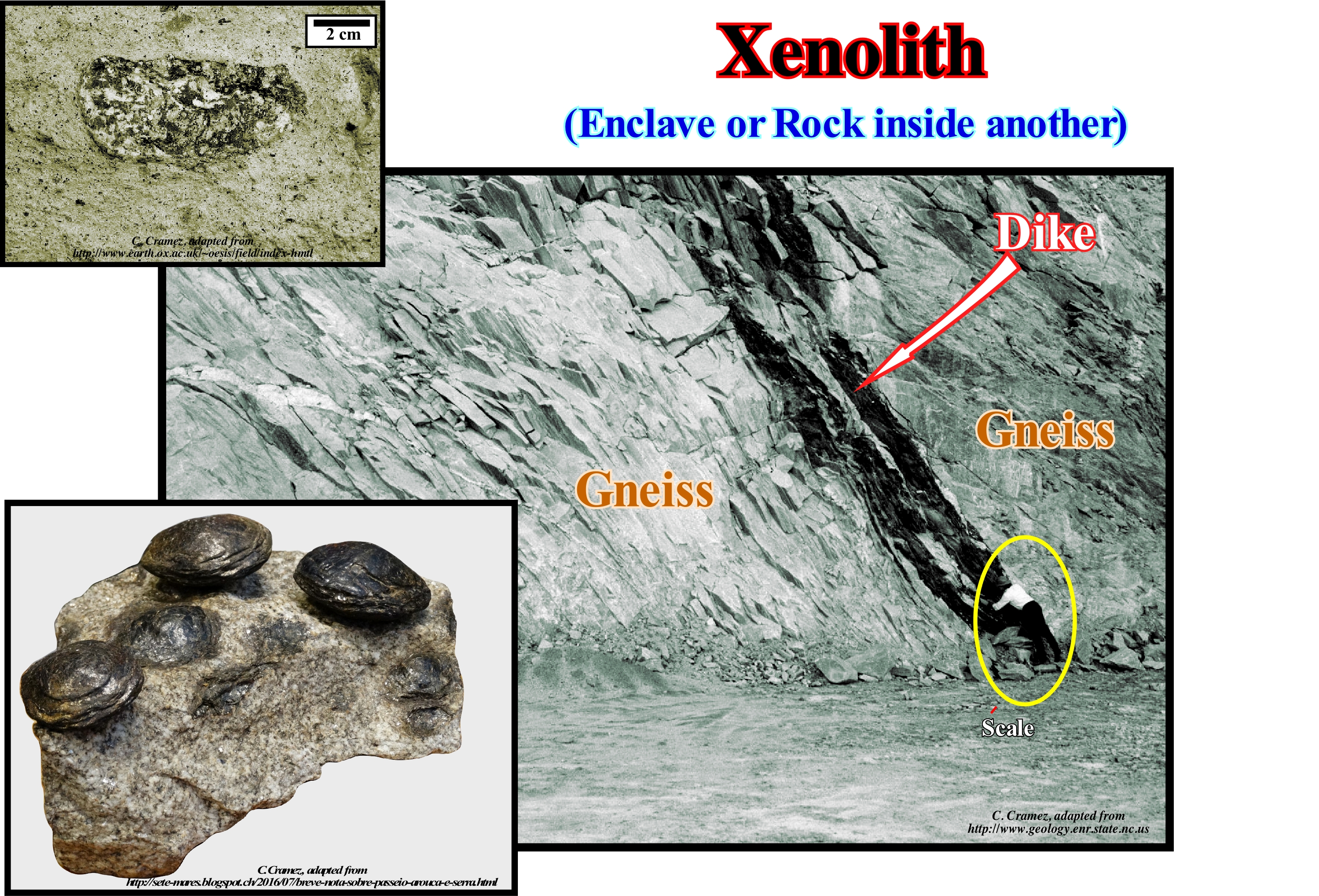

Xenolith.................................................................................................................................................................................................................................Xénolithe
Xenólito / Xenólito / Xénolite / ²¶Â²ÑÒ (Ò쾧Ìå) / §¬§ã§Ö§ß§à§Ý§Ú§ä / Xénolite /
Term used to describe visible inclusions within an igneous rock. Currently, the term xenolith is, also, used, by certain geoscientists, to designate any fragment of rock included within a more recent rock.
See : « Rock Cycle »
&
« Geological Principle »
&
« Scale »

Within the intrusive igneous rocks, very often, as in this gneiss quarry, small inclusions or xenoliths of the rock are found within the gneiss. As in this example, the size of xenoliths (literally foreign rock), which are older than the gneiss, is very small and therefore they are not discernible in photography. The geoscientist is observing a dike that penetrated the gneiss, obliquely, into its foliation*. The geometric relations between the dike and the gneiss corroborate the intrusion geological principle (an igneous intrusive rock is younger than the rock it penetrates) and show that the dike is more recent than the gneiss. Therefore,the dike can not be considered as a xenolith. A tentative interpretation of the geological history of this quarry can be summarized as follows: (i) Deposition of a sedimentary interval in association with eustasy (absolute or eustatic sea level changes) and tectonics (subsidence or uplift of the sea floor) ; (ii) Burial of the sedimentary interval to a depth such that some of the sedimentary intervals were metamorphosed giving rise to a quartz-biotite gneiss (xenolithic source-rock) with small xenoliths of preexistent rocks ; (iii) Intrusion of a dike cutting the gneiss foliation. In Serra da Freita, in the vicinity of Castanheira (Portugal), the "calving granite" outcrop is a magnificent place to observe xenoliths (lower left corner of this figure). Granite has xenoliths, from the rock it has penetrated, in the form of a biconvex disk, and which are, more or less, enveloped in a layer of biotite. As a result of erosion, xenoliths are released from the granite that the local population calls "calving rock". A xenocrystal, which is a foreign crystal included in an igneous body, is not a xenolith. A true xenolith has to be a type of rock different from that of the encasing rock, otherwise it is an autolith or relative inclusion. An autolith is distinguished from a xenolith (which literally means strange rock) which is a fragment of any other type of rock plucked from the nesting rocks and surrounded by the magma of the intrusion. The xenoliths also occur in the volcanic rocks (top left of the figure). They can be blocks of the surrounding rock or come from the deep parts where the magma forms. In this example, the xenolith was, partially, metamorphosed by the lava that encloses it. The understanding of xenoliths obeys the geological principle of intrusion which says an intrusive igneous rock is younger than the rock it penetrates. In geology. besides the principle of Intrusion, mentioned above there are many other principles, such as: a) Principle of Composition, a rock represented by fragments in another rock is older than the rock that contains them ; b) Principle of the Carbonated Bucket, the architecture of the growth of a rimmed carbonated platform resembles the geometry of a bucket or inverted cone trunk ; c) Principle of Original Horizontality, the sedimentary layers deposit horizontally (not totally true) ; d) Principle of Intersection, the most recent veins or dikes displace the oldest ones ; e) Principle of Ochkam, plurality should not be invoked without necessity: "Pluritas non est ponenda sine necessitate" ; f) Goguel's Principle, during the deformation, the volume of the sediment is, more or less, constant ; g) Principle of the Original Lateral Continuity, the sedimentary layers deposit in lateral continuity ; h) Walther's Principle, in conforming strata, vertically succeeding facies occur also, laterally, in adjacent environments ; (i) Dextrological Principle, if a reference system rotates clockwise, the deflection (Coriolis effect) is to the left of the object, in the direction of movement ; j) Uniformity Principle, the geological changes are mainly due to the same processes and continuous changes that are currently observed ; k) Principle of Superposition, in a sedimentary series, slightly, deformed, the oldest layers are in the base and the most recent layers above ; l) Principle of Catastrophism, changes that occurred on Earth were due to the occurrence of major natural disasters ; m) Principle of Continental Drift, the continental masses have a small density and, for that reason, they floated on the dense masses of the ocean, moving and changing the surface of the planet ; n) Principle of Plate Tectonics, it is not the continents that move, but the lithospheric plates that contain these continents, etc., etc.
(*) A generic term to refer to any planar, repetitive, penetrative structure, along which the rock tends to break preferentially, but not should be applied to minerals, as foliation in minerals is the result of cleavage.
Send E-mails to carloscramez@gmail.com or to carlos.cramez@bluewin.ch with comments and suggestions to improve this glossary.
Copyright © 2009 CCramez, Switzerland
Last updated: Septembre, 2019